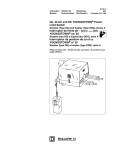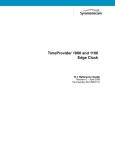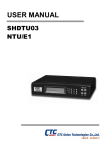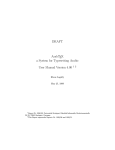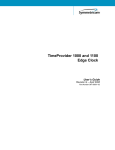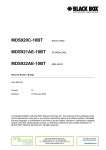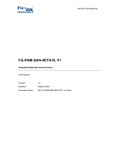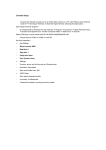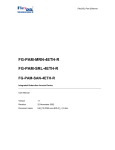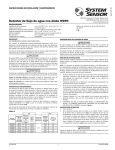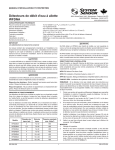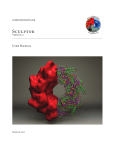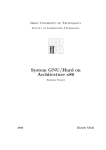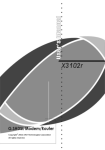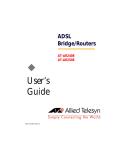Download X3208a User`s Manual Version 2.1 1 / 62
Transcript
X3208a User’s Manual Version 2.1 1 / 62 X3208a User’s Manual Version 2.1 XAVi Technologies Corporation Tel: +886-2-2995-7953 9F, No. 129, Hsing Te Road, Sanchung City, Taipei Hsien 241, Taiwan (R.O.C.) Copyright © 2003, XAVi Technologies Corporation Information in this manual is subject to change without notice. No part of this manual may be reproduced or transmitted in any form or by any means, electronic or mechanical, including photocopying or scanning, for any purpose, without the written permission of XAVi Technologies Corporation. XAVi Technologies Corporation provides this documentation without warranty of any kind, implied or expressed, including, but not limited to, the implied warranties of merchantability and fitness for a particular purpose. 2 / 62 X3208a User’s Manual Version 2.1 Table of Contents Chapter 1 – Getting Started I. II. III. IV. V. VI. Overview……………………………..………….…..…………….…….…. 6 Features….……………………….…………………………….………..… 7 Relevant Protocol Information….…………………………………………7 Packaging………...…………………………………………………...…… 8 Safety Guidelines…………………….……...…..….………………….…. 9 Appearance……………………………………….………..……..……… 10 Front Panel…….……………………………..………..………….……… 10 Rear Panel…….….……..…..……………………..….…………….…… 11 VII. Application…………………………………………………………………12 VIII. Hardware Installation……………………………………………….…… 14 IX. Management…………………………..…………………………………. 15 X. Default Values………………………………………...……….………….16 XI. Software Upgrade…………………………………..…………………… 18 Chapter 2 – Command Line Interface I. II. Console Setup..……………...…….….……………………..……..…….17 Command Tree Structure……………………………………………….. 18 A. Main Menu Command List……………………………..……….. 20 B. Data Menu Command List………………………………….…… 20 C. FRN Menu Command List…………………………………….… 21 D. FRS Menu Command List…………………….……………..….. 22 E. LAN Menu Command List………………………………………. 22 F. Manage Menu Command List………………………….………. 22 G. R1483 Menu Command List……………………………….…… 23 H. SHDSL Menu Command List…………………………..………. 23 III. CLI Commands……...……………….…………………..……………… 24 A. Main Menu Commands………………………………………….. 26 B. Data Menu Commands………………………………………..… 31 C. FRN Menu Commands…….……………………………………. 39 D. FRS Menu Commands…………….……..…………………….. 41 E. LAN Menu Commands………………………………………….. 42 F. Manage Menu Commands…………………………..…………. 44 G. R1483 Menu Commands………………………………..……… 46 H. SHDSL Menu Commands……………………….……………… 48 3 / 62 X3208a User’s Manual Version 2.1 Table of Contents Appendix A – Connector Pin Assignments…..….………..……52 Appendix B – Specifications B1. Hardware Specifications..……………………..………………………..…. 56 B2. Software Specifications……………………….………….……….…….…. 57 Appendix C– Warranties C1. Product Warranty……………….………………………..………..……….. 58 C2. Warranty Repair…………………………………………..…………..….… 58 C3. Out-of-Warranty Repair. …………………………………..……………….59 Appendix D – Regulations D1. FCC Part 15 Notice……………………………………..……...………….. 60 D2. IC CS-03 Notice……….……………………..…………..…………….…... 62 Contact Information………………………...……….…..….…………… 62 4 / 62 X3208a User’s Manual Version 2.1 Revision Marks Revision Date Notes V 1.0 November 16, 2002 Software: Version: N/A V 2.0 June 11, 2003 Software Version: N/A V 2.1 June 19, 2003 Software Version: 1.00XAF2.J8I-H08.1004FR1.7-2.74B 22/Nov/2002 11:30 5 / 62 X3208a User’s Manual Version 2.1 Chapter 1 Getting Started I. Overview Based on the ITU-T G.991.2 G.SHDSL standard, X3208a Single-pair High-speed Digital Subscriber Line (SHDSL) product series provides a Frame Relay and ATM interworking transport infrastructure for Public Network WAN access, high-speed Internet access, LAN-to-LAN connectivity, and other high-speed data access applications. It is ideal for Network Service Providers who wish to deliver high-speed data transmissions to their customers. The WAN interface provides programmable symmetrical rate from 72Kbps to 2312Kbps by adapting to the DSU application. The SHDSL interface of X3208a can be configured to interoperate with SHDSL DSLAM or to fit Point-to-Point data transmission applications by flexible COE/CPE configurations. The Data interface of X3208a can be configured to connect with existing Frame Relay routers. Note: Two Implementation Agreements (IAs) in Frame Relay forum have been developed specifically for current frame relay users: Network Interworking (FRF.5) and Service Interworking (FRF.8). Both solutions protect current investments in frame relay while providing a migration path to ATM. 6 / 62 X3208a User’s Manual II. Version 2.1 Features High Speed Symmetrical Data Transmission on a Single Twisted Copper Pair Wire. SHDSL Line Code: PAM Data port with multi-protocol support V.35/RS530, X.21. Provides FRF.5 Frame Relay/ATM Network Interworking function. Provides FRF.8 Frame Relay/ATM PVC Service Interworking function. Nx64Kbps rate configurable to prolong the loop reach. High performance, simple operation, low power consumption. Compatible and interoperable with major Central Office side symmetric DSL DSLAM. Local OAM&P via RS-232 Craft port or by telnet through auto-negotiation of 10/100BaseT port. Provides loop-back function for easy maintenance. III. Relevant Protocol Information FRF.5, Frame Relay/ATM PVC Network Interworking Implementation Agreement FRF.8.1, Frame Relay/ATM PVC Service Interworking Implementation Agreement RFC 1483, Multi-protocol Encapsulation over AAL 5 (July 1993) RFC 1490, Multi-protocol Encapsulation over Frame Relay Rec. Q.933, Layer 3 Signaling Specification for Frame Mode Bearer Services af-uni-0010.002, ATM User-Network Interface (UNI), v3.1 7 / 62 X3208a User’s Manual IV. Version 2.1 Packaging This package consists of the following items: X3208a SHDSL Router RJ-11 Cable RJ-45 Cable RS-530 to V.35 Cable RS-530 to X.21 Cable (Optional) AC Adapter User’s Manual CD-ROM 8 / 62 X3208a User’s Manual V. Version 2.1 Safety Guidelines In order to reduce the risk of fire, electric shock and injury, please adhere to the following safety guidelines. Carefully follow the instructions in this manual; also follow all instruction labels on this device. Except for the power adapter supplied, this device should not be connected to any other adapters. Do not spill liquid of any kind on this device. Do not place the unit on an unstable stand or table. This unit may drop and become damaged. Do not expose this unit to direct sunlight. Do not place any hot devices close to this unit, as it may degrade or cause damage to it. Do not place any heavy objects on top of this unit. Do not use liquid cleaners or aerosol cleaners. Use a soft dry cloth for cleaning. 9 / 62 X3208a User’s Manual VI. Version 2.1 Appearance Front Panel Label Status Color Description PWR ON Green Power supply is connected properly. ON Green Frame sync over multi-protocol. Blinking Green Transmitting data over multi-protocol. ON Red Loss of signal alignment. ON Green Frame sync over multi-protocol. Blinking Green Receiving data over multi-protocol. ON Red Loss of signal alignment. Blinking Green Training with DSLAM. ON Green SHDSL link is ready. Blinking Red Booting up. ON Red Error. TX RX WAN ALM 10 / 62 X3208a User’s Manual Version 2.1 Rear Panel Label Description PWR DC-inlet for AC Adapter. CONSOLE Serial port; connect to an ASCII data terminal. ETHERNET RJ-45 port; connect to a PC or LAN. V.35/RS-530 DB-25 port; connect to a multi-protocol router. WAN RJ-11 port; connect to the SHDSL outlet. 11 / 62 X3208a User’s Manual VII. Version 2.1 Application The most common applications for SHDSL DSU are used for lease line high-speed data transmission. Network Interworking – Scenario 1 FR Network FR Network FR Network Router Router X3208a X3208a Network Interworking – Scenario 2 FR Network FR Network ATM Network is not FR “aware” Router X3208a ATM Router 12 / 62 X3208a User’s Manual Version 2.1 Service Interworking – Transparent Mode FR Network FR Network ATM Network is not FR “aware” Router X3208a ATM Router Transparent Payload Transport (No Protocol Processing) ATM AAL5-CPCS (FR Headers NOT Preserved) Service Interworking – Translation Mode FR Network FR Network ATM Network is not FR “aware” Router X3208a ATM Router RFC 1490/FR -- Translate Encapsulation -- RFC 1483/ATM ATM AAL5-CPCS (FR Headers NOT Preserved) Applications: 1. Lease line high-speed data transmission with Public Network. 2. Point-to-point high-speed data transmission for campus or other applications. 13 / 62 X3208a User’s Manual VIII. Version 2.1 Hardware Installation 1. Connect one end of the RJ-11 cable into the WAN port of X3208a, and the other end into the SHDSL wall outlet. 2. Connect one end of the V.35/X.21 cable to connect to X3208a and the other end to a V.35/X.21 router. 3. Connect one end of the RJ-45 cable into one of the RJ-45 ports of X3208a, and the other end into your PC or LAN. 4. Plug in the AC adapter into the AC power socket, and connect the DC jack into the PWR inlet of X3208a. 5. Use a 9-pin RS-232 cable to connect the Console cable to the RJ-45 cable then to a PC with data terminal emulation software (Hyper Terminal) installed, in order for local management. 4 5 3 2 1 V.35/X.21 Router Power Supply PC SHDSL Outlet Management Terminal 14 / 62 X3208a User’s Manual IX. Version 2.1 Management Console Port – use the RS-232 cable for connecting X3208a to a console terminal or a PC running a terminal emulation program, such as Hyper Terminal. (For further details, See Chapter 2: Command Line Interface) Local Ethernet Port (Telnet) – connect the Ethernet port to your local area network or directly to a PC, “telnet” X3208a from any workstation in the LAN. The default local Ethernet IP address is “192.168.1.1”. Note: As operating an SHDSL device requires technical know-how and experience. It is recommended that only qualified technical staffs manage X3208a. Therefore, a password authentication is required when you enter the command line and web interface. See the Default Values section to obtain the password. 15 / 62 X3208a User’s Manual X. Version 2.1 Default Values X3208a is pre-configured with the following parameters; you may also re-load the default parameters by typing Default in the command line interface. (For further details, See Chapter 2: Command Line Interface) Password: 0000 Multi-protocol Setting Interface: V.35 Terminal: DCE Clock source: Internal txdatainv -- normal txclkinv – normal rxdatainv – normal rxclkinv -- normal rts -- enable dtr -- enable cts -- enable dsr --enable dcd --enable (Local) loopback: disable Rate -- 2048Kbps SHDSL Terminal: CPE (RT) side Rate Mode: Adaptive Line Rate Range: Max: 2056Kbps Min: 72Kbps Framer Type: Utopia SHDSL Standard: annex B Frame Relay Setting FR management - 0.no maintenance FRF.12 segment -0 Autostart - false N391 protocol -6 User N392 -3 Network N392 -3 User N393 -4 Network N393 -4 T391 timer - 10 T392 timer - 16 16 / 62 X3208a User’s Manual Version 2.1 Frame Relay Service Interworking FUNCTION Frs VPI/VCI CLASS LLC/VCMUX Spanning *8/36 ubr LLC Disable Pkt Filter DLCI Trans DE FECN ANY 100 1 2 2 clpi mux hdr dc Remote Management FUNCTION Rfc 1483 Pkt Filter VPI/VCI CLASS LLC/VCMUX Spanning *8/35 ubr LLC Disable DLCI Trans DE ANY 17 / 62 FECN clpi mux hdr dc X3208a User’s Manual XI. Version 2.1 Software Upgrade You may easily upgrade X3208a embedded software by obtaining the compressed upgrade kit from the service provider then following the steps: Extract the ZIP file for updated firmware Connect X3208a via the local Ethernet port or remote ADSL link, make sure that X3208a Ethernet IP address and your terminal are properly configured so that you can successfully “ping” X3208a. The default local IP address is 192.168.1.1. Under the DOS prompt, execute the command “xupgrade <IP address of X3208a >”, for instance “xupgrade 192.168.1.1”. This upgrading process may last as long as 60 seconds. Then reboot X3208a with new software. Note: Strictly maintain stable power to X3208a while upgrading its software. If the power fails during the upgrading process, contents in the memory could be destroyed, and the system may hang. In such as case, you must call the dealer or system integrator for repairs. 18 / 62 X3208a User’s Manual Version 2.1 Chapter 2 Command Line Interface I. Console Setup Connect the RS-232 console port to an ASCII data terminal or a PC with Widows serial Terminal mode of VT-100 (Hyper Terminal). To Start the Hyper-terminal, follow the steps below. 1. Start "Hyper-terminal" program On Windows 98 or Windows NT: Click on the Start button Programs Accessories Terminal Group Double Click “Hypertrm.exe” Connection Name Select Icon Click OK 2. Select a COM port to communicate with X3208a Choose direct to COM1 or COM2 and click on OK 3. Set Port Properties - - Port Setting: Bit per second: 9600 Data bits: 8 Stop bits: 1 Parity bits: None Flow Control: None Settings: Function, arrow, and ctrl keys act as: Windows keys Emulation: Auto-detect Back-scroll buffer lines: 500 ASCII Setup: Echo typed characters locally Line delay: 0 milliseconds Character line feeds incoming line ends: enable 19 / 62 Hyper Enter X3208a User’s Manual II. Version 2.1 Command Tree Structure A. Main Menu Command List Command Description data Entry to Frame Relay and Multiprotocol menu default Set all configuration to factory setting frn Entry to Frame Relay and ATM Network Interworking menu (FRF.5) frs Entry to Frame Relay and ATM Service Interworking menu(FRF.8) lan Entry to Ethernet menu list List status for enabled PVC manage Entry to management menu ping Ping IP for testing purpose quick Quick setup r1483 Entry to RFC1483 menu restart Reboot modem save Save and restart modem shdsl Entry to SHDSL menu show Display configuration of PVC and Ethernet ver Display software version B. DATA Menu Command List Command Description version Display Frame Relay and Multiprotocol module version default Setting all data configuration back to factory setting Status Display the configuration and status of current Frame Relay and Multiprotocol setting enable Activate the last updated Frame Relay and Multiprotocol parameters interface Configure Multiprotocol interface mode 20 / 62 X3208a User’s Manual Version 2.1 terminal Configure Multiprotocol terminal mode clock Set multi-protocol Clock source rate Set internal clock rate cts Set Multiprotocol Clear to send dsr Set Multiprotocol Data set ready dcd Set Multiprotocol DataCarrierDetect rts Set Multiprotocol Request To Send dtr Set Multiprotocol Data Terminal Ready rxclkinv Set Multiprotocol Rx Clock Invert rxdatainv Set Multiprotocol Rx Data Invert txclkinv Set Multiprotocol Tx Clock Invert txdatainv Set Multiprotocol Tx Data Invert loopback Set Multiprotocol loopback ll Set Multiprotocol Local Loopback frmtype Set Frame Relay Management protocol type autostart Set Frame Relay port automatically start t391 Set Frame Relay T391 timer value t392 Set Frame Relay T392 timer value n391 Set Frame Relay N391 protocol value un392 Set Frame Relay User side N392 protocol value nn392 Set Frame Relay Network side N392 protocol value un393 Set Frame Relay User side N393 protocol value nn393 Set Frame Relay Network side N393 protocol value segsize Set FRF.12 segment size C. FRN Menu Command List Command Description delpvc Delete VPI and VCI setclpi Set ATM to Frame Relay CLPI mapping 21 / 62 X3208a User’s Manual Version 2.1 setdc Set DC field value in Frame Relay DLCI header setde Set Frame Relay to ATM DE mapping sethdr Set Frame Relay header type setpvc Set FRF.5 VPI/VCI and DLCI(numbers<=10) show Show all VPI/VCI channel configuration D. FRS Menu Command List Command Description delpvc Delete VPI and VCI setde Set DE and CLPI mapping setfecn Set FECN and EFCI mapping setpvc Set FRF.8 VPI/VCI and DLCI (numbers<=2) settrans Set Translation or Transparent Mode show Show all VPI/VCI channel configuration E. LAN Menu Command List Command Description fullduplex Full duplex and half duplex setip Setup the IP address, and subnet mask for Ethernet connection show Show LAN configuration F. MANAGE Menu Command List Command setpass Description Change password 22 / 62 X3208a User’s Manual Version 2.1 G. R1483 Menu Command List Command Description delpvc Delete VPI and VCI pfilter Set packet filter type setpvc Set VPI and VCI for bridge mode setqos Set class setspan <Enable>|<Disable> spanning tree show Show RFC1483 configuration H. SHDSL Menu Command List Command Description adapt set adaptive mode default set SHDSL configuration back to factory setting enable activate the last updated SHDSL parameters fix set fixed mode margin set gd2237 Margin (useable on adaptive) status display the configuration and status of SHDSL setting terminal configure modem to COE or CPE mode 23 / 62 X3208a User’s Manual III. Version 2.1 CLI Commands The command line interface allows you to change SHDSL and Ethernet parameters, and display the status. Some commands must be followed by parameters for proper configuration to the device, conventionally there shall be a “space” between a command and its corresponding parameters. The punctuation marks in command line interface have their different meanings, in the syntax < > means that the enclosed parameters are compulsory; [ ] means the enclosed parameters are optional, and | between the parameters means either….or. In the parameters section “ ” means the enclosed parameters are Key Words. Furthermore, after entering the password, screen will show the prompt, such as >>, for entering the commands. The next few sections describe the commands along with examples. HELP or ? Lists all commands at the current level and follow by simple description of each command. Syntax: help Parameters: Example: >>help Syntax: ? Parameters: Example: >> ? HELP <command> or ? <command> Display the usage of particular command in each level. Syntax: help <command> Parameters: command: Enter each command Example: > lan> help setip Display the syntax of setip command Response: setip - setip <etherip[/<masknum>] [subnet mask]> 24 / 62 X3208a User’s Manual Version 2.1 Syntax: ? <command> Parameters: command: Enter each command Example: >lan> ? setip Response: Display the syntax of setip command Setip - setip <etherip[/<masknum>] [subnet mask]> HOME Go back to the upper level. Syntax: Home Parameters: Example: >> home Note 1: The connection will time out after 3 minutes if there is no access to device. You must re-enter the password to resume the connection. Note 2: All settings will take effect only after they have been saved. 25 / 62 X3208a User’s Manual Version 2.1 A. Main Menu Commands DATA Enter to DATA configuration menu. Refer to DATA Menu Commands for more details. Syntax: Data Parameters: Example: >> data Default Set all configurations to factory setting. Syntax: default Parameters: Example: >> default FRN Enter to the Frame Relay and ATM Network Interworking menu (FRF.5). Refer to FRN Menu Commands for more details. Syntax: frn Parameters: Example: >> frn FRS Enter to the Frame Relay and ATM Service Interworking menu (FRF.8). Refer to FRS Menu Commands for more details. Syntax: frs Parameters: Example: >> frs 26 / 62 X3208a User’s Manual Version 2.1 LAN Enter to LAN menu. Refer to LAN Menu Commands for more details. Syntax: lan Parameters: Example: >> lan MANAGE Enter to MANAGE configuration menu. Refer to MANAGE Menu Commands for more details. Syntax: Manage Parameters: Example: >>manage PING Ping a specific IP address for testing purpose. Syntax: ping <ipaddress> Parameters: ipaddress: IP address, in the format of 4 decimals separated by dots Example1: >> ping xxx.xxx.xxx.xxx Response: >>Press 'ESC' to break >> ip: ping - reply received from xxx.xxx.xxx.xxx Explanation: Successful ping Example2: >> ping 192.168.1.1 Response: >> Invalid IP Explanation: Invalid IP address Example3: > >ping xxx.xxx.xxx.xxx Response: >>Press 'ESC' to break >>ip: ping – no reply received Explanation: Wrong IP address 27 / 62 X3208a User’s Manual Version 2.1 QUICK Enter a VC with RFC1483/bridge mode by an interactive user interface. Syntax: quick Parameters: Example: > quick Response: 1 PVC existed, 7 PVCs available. VPI(0-4095): 2[Enter] VCI(1-65535): 34[Enter] PCR(0-800):640[Enter] Packet Filter ( Any/Ip/Pppoe ): a[Enter] Add another PVC ? (y/n):n[Enter] Enable Spanning tree? (y/n) : y[Enter] Configuration MODE: Bridge FUNCTION: R1483 Spanning Tree: Enabled # VPI VCI 1: 2 34 PCR 640 Packet Filter ANY Preserve the configuration (y/n): y[Enter] Configuration will have no effect until after save and restart. R1483 Enter to R1483 menu. Refer to R1483 Menu Commands for more details. Syntax: r1483 Parameters: Example: > r1483 28 / 62 X3208a User’s Manual Version 2.1 RESTART Reboot the SHDSL DSU. Syntax: restart Parameters: Example: > restart Response: SDRAM size = 0x800000 Booting System start Password: SAVE Save the configuration into flash memory, and restart DSU. Syntax: save Parameters: Example: > save Response: Saving configuration… Configuration saved. Updating flash file system… SDRAM size=0*800000 Done Booting… System start… Password: Save the configuration and then restart DSU. 29 / 62 X3208a User’s Manual Version 2.1 SHDSL Enter to SHDSL configuration menu. Refer to SHDSL Menu Commands for more details. Syntax: shdsl Parameters: Example: > shdsl VER Display software version. Syntax: ver Parameters: Example: >ver Response: Version: 1.00XAF2.J8I-H08.1004-FR1.7-2.74B 22/Nov/2002 11:30 30 / 62 X3208a User’s Manual Version 2.1 B. DATA Menu Commands VERSION Display Frame Relay and Multiprotocol module version. Syntax: version Parameters: Example: >data>version Response: Version: 1.01(FRIW) DEFAULT Set all data configuration back to factory setting. Syntax: default Parameters: Example: >data> default Response: The data set to default successfully. STATUS Display the configuration and status of current Frame Relay and Multi-protocol setting. Syntax: status Parameters: Example: > data> status Response: Frame Relay : FR management - 0.no maintenance FRF.12 segment -0 Autostart N391 protocol User N392 Network N392 User N393 - false -6 -3 -3 -4 31 / 62 X3208a User’s Manual Version 2.1 Network N393 -4 T391 timer - 10 T392 timer - 16 Config: interface - v35 terminal - dce ll - disable rts - enable dtr - enable cts - disable dsr - disable dcd - disable loopback clock txdatainv txclkinv rxdatainv rxclkinv rate - disable - internal - normal - normal - normal - normal - 2048 Status: interface - v35 terminal - dce ll Explanation: - disable rts - disable dtr - disable cts - enable dsr - enable dcd - enable loopback - disable 32 / 62 X3208a User’s Manual clock txdatainv txclkinv rxdatainv Version 2.1 - internal - normal - normal - normal rxclkinv - normal rate - 2048 ENABLE Activate the last updated multi-protocol parameters without saving and restarting system. Syntax: Enable Parameters: Example: >data> enable INTERFACE Configure multi-protocol interface mode. Syntax: interface <eia530>|<x21>|<v35> Parameters: Example: >data> interface v35 TERMINAL Configure Multi-protocol terminal mode. Syntax: terminal <dce>|<dte> Parameters: Example: >data> terminal dce 33 / 62 X3208a User’s Manual Version 2.1 CLOCK Configure determines the direction and source of the transmit clock. Syntax: clock < internal >|<external> Parameters: “internal”: Internal Clock “external”: external Clock Example: >data> clock internal RATE Set the internal clock rate. Syntax: rate <rate> Parameters: 64 to 2048: decimal value of rate (Kbps). Please refer the rate setting below: Example: >shdsl> rate 2048 Set multipotocol data rate to 2048Kbps. CTS Set Multi-protocol clear to send. Syntax: cts<enable>|<disable> Parameters: “enable”: enable cts “disable”: disable cts Example: >data> cts enable DSR Set Multiprotocol Data Set Ready. Syntax: Dsr<enable>|<disable> Parameters: “enable”: enable dsr “disable”: disable dsr Example: >data> dsr enable 34 / 62 X3208a User’s Manual Version 2.1 DCD Set Multi-protocol data carrier detect. Syntax: dcd<enable>|<disable> Parameters: “enable”: enable dcd “disable”: disable dcd Example: >data> dcd enable RTS Set Multi-protocol Request To Send Syntax: Rts<enable>|<disable> Parameters: “enable”: enable rts “disable”: disable rts Example: >data> rts enable DTR Set Multi-protocol Data Terminal Ready. Syntax: Dtr<enable>|<disable> Parameters: “enable”: enable dtr “disable”: disable dtr Example: >data> dtr enable RXCLKINV Configure determines the Rx clock normal or invert from multiprotocol. Syntax: rxclkinv < invert>|<normal> Parameters: “normal”: Rx clock normal “invert”: Rx clock invert Example: >data> rxclkinv normal 35 / 62 X3208a User’s Manual Version 2.1 RXDATAINV Configure determines the Rx data normal or invert from multiprotocol. Syntax: rxdatainv < invert>|<normal> Parameters: “normal”: Rx data normal “invert”: Rx data invert Example: >data> rxdatainv normal TXCLKINV Configure determines the TX clock normal or invert from multiprotocol. Syntax: txclkinv < invert>|<normal> Parameters: “normal”: Tx clock normal “invert”: Tx clock invert Example: >data> txclkinv normal TXDATAINV Configure determines the TX data normal or invert from multiprotocol. Syntax: txdatainv < invert>|<normal> Parameters: “normal”: Tx data normal “invert”: Tx data invert Example: >data> txdatainv normal 36 / 62 X3208a User’s Manual Version 2.1 LOOPBACK This command is used to verify if the SHDSL interface data path works normally and in the same time the data port also been set to loopback mode such that external tester can verify if the data port works normally. Syntax: loopback<enable>|<disable> Parameters: “enable”: enable loopback “disable”: disable loopback Example: >data>loopback enable LL This command is used to set the multi-protocol data port to loopback mode. Syntax: ll<enable>|<disable> Parameters: “enable”: enable “disable”: disable Example: >data> ll enable FRMTYPE Set Frame Relay Management protocol type. Syntax: frmtype <num> Parameters: Num: <0.no_maintenance>|<1.933A_Network>|<2.933A_User>|<3. 933A_Both>|<4.617D_Network>|<5.617D_User>|<6.617D_Bo th>|<7.LMI_Network>|<8.LMI_User>|<9.LMI_Both> Example: >data> frmtype 0 37 / 62 X3208a User’s Manual Version 2.1 AUTOSTART Set Frame Relay port to automatically start. Syntax: autostart <true>|<false> Parameters: “true”: enable “false”: disable Example: >data> autostart enable t391; t392 Set Frame Relay T391/T392 timer value. Syntax: t391 <1>|~|<65535>; t392 <1>|~|<65535> Parameters: Example: >data>t391 10 n391/ un392/ nn392/ un393/ nn393 Set Frame Relay N391/ User side N392/ Network side N392/ User side N393/ Network side N393 protocol value. Syntax: t391 <1>|~|<65535>; t392 <1>|~|<65535> Parameters: Example: >data>t391 10 SEGSIZE Set FRF.12 segment size. Syntax: segsize <0>|~|<65535>, which 0 disable FRF.12 segmentation Parameters: Example: >data>segsize 0 38 / 62 X3208a User’s Manual Version 2.1 DEFAULT Set all configurations to factory setting. Syntax: Default Parameters: Example: > default C. FRN Menu Commands DELPVC Delete VPI and VCI. Syntax: delpvc <all>|[<vpi>/]<vci> Parameters: Example: >frn>delpvc all SETCLPI Set ATM to Frame Relay CLPI mapping. Syntax: setclpi [<vpi>/]<vci> [clpi] Parameters: which clpi=0 set according to FR SSCS only clpi=1 use both FR SSCS and ATM layer indications Example: >frn>setclpi 8/35 0 SETDC Set DC field value in Frame Relay DLCI header. Syntax: setdc [<vpi>/]<vci> [dc] Parameters: dc=0~1 Example: >frn>setdc 8/35 0 39 / 62 X3208a User’s Manual Version 2.1 SETDE Set Frame Relay to ATM DE mapping. Syntax: setde [<vpi>/]<vci> [de] Parameters: which de=0 map DE and always set CLPI to 0 de=1 map DE and always set CLPI to 1 Example: >frn>setde 8/35 0 SETHDR Set Frame Relay to ATM DE mapping. Syntax: sethdr [<vpi>/]<vci> [header type] Parameters: which header type=2~4 bytes Example: >frn>sethdr 8/35 2 SETPVC Set FRF.5 VPI/VCI and DLCI (numbers<=10). Syntax: setpvc [<vpi>/]<vci> [dlci] [llc/vcmux] Parameters: which vpi=0~4095, vci=1~65535 and dlci=1~1023 Example: >frn>setpvc 8/35 171 SHOW Show all VPI/VCI channel configuration. Syntax: show Parameters: Example: >frn>show 40 / 62 X3208a User’s Manual Version 2.1 D. FRS Menu Commands DELPVC Delete VPI and VCI. Syntax: delpvc <all>|[<vpi>/]<vci> Parameters: Example: >frs>delpvc all SETDE Set DE and CLPI mapping. Syntax: setde [<vpi>/]<vci> [de] Parameters: which de=0 always set 0 to CLPI de=1 always set 1 to CLPI de=2 convert from DE to CLPI Example: >frs>setde 8/35 0 SETFECN Set FECN and EFCI mapping. Syntax: setfecn [<vpi>/]<vci> [fecn] Parameters: which fecn=0 always set 0 to FECN fecn=1 always set 1 to FECN fecn=2 convert from EFCI to FECN Example: >frs>setfecn 8/35 0 41 / 62 X3208a User’s Manual Version 2.1 SETPVC Set FRF.8 VPI/VCI and DLCI (numbers<=2). Syntax: setpvc [<vpi>/]<vci> [dlci] [llc/vcmux] Parameters: which vpi=0~4095, vci=1~65535 and dlci=1~1023 Example: >frs>setpvc 8/35 171 SETTRANS Set Translation or Transparent Mode. Syntax: settrans [<vpi>/]<vci> [translation] Parameters: which translation=0 is running Transparent Mode translation=1 is running Translation Mode Example: >frs>settrans 8/35 0 SHOW Show all VPI/VCI channel configuration. Syntax: show Parameters: Example: >frs>show E. LAN Menu Commands FULLDUPLEX Set full duplex or half duplex. Syntax: fullduplex <Disable>|<Enable> Parameters: Disable: halfduplex Enable: fullduplex Example: > lan> fullduplex enable 42 / 62 X3208a User’s Manual Version 2.1 SETIP Setup the IP address, and subnet mask for the Ethernet LAN connection. Syntax: setip <etherip[/<masknum>]>[subnet mask] Parameters: etherip: Ethernet IP address, in the format of 4 decimals separated by dot subnet mask: Subnet mask, the default is 255.255.255.0 Example: > lan> setip 192.168.2.32 SHOW Display the current configuration of Ethernet. Syntax: show Parameters: Example: > lan> show 43 / 62 X3208a User’s Manual Version 2.1 LIST List status for enabled PVC. Syntax: list Parameters: Example: lan> list Response: Port ethernet1 0: edd TxPkts: 1/0 RxPkts: 0/0 Port hdlc has no open channels Port shdsl 0: bridge TxPkts: 1/0 RxVPI/VCI: 8/35 RxPkts: 0/0 TxVPI/VCI: 8/35 1: oam TxPkts: 0/0 RxVPI/VCI: 0/0 RxPkts: 0/0 TxVPI/VCI: 0/0 2: oam TxPkts: 0/0 RxVPI/VCI: 0/0 RxPkts: 0/0 TxVPI/VCI: 0/0 3: oam TxPkts: 0/0 RxVPI/VCI: 0/3 RxPkts: 0/0 TxVPI/VCI: 0/0 4: oam TxPkts: 0/0 RxVPI/VCI: 0/4 RxPkts: 0/0 TxVPI/VCI: 0/0 F. MANAGE Menu Commands SETPASS Change password. Syntax: setpass Parameters: Up to 18 alphanumeric characters. Upper case and lower case are different numbers. Example: For enabling a new password > manage> setpass Response: Password disabled!! New Password: **** Confirm password again: **** 44 / 62 X3208a User’s Manual Version 2.1 Password has been changed. Saving configuration...Configuration saved. Explanation: Example 2: You will be asked to key in new password and confirm the new password again. For changing old password: > manage> setpass Response: Old Password: **** New Password (press ENTER to disable): **** Confirm password again: **** Password has been changed! Saving configuration...Configuration saved. Explanation: You will be asked to key in old password. Type the new password and confirm the new password again. For disabling old password: Example 3: > manage> setpass Old Password: ******** Response: New Password (press ENTER to disable): Are you sure to disable password (y/n)? Password has been disabled! Saving configuration...Configuration saved. Explanation: You will be asked to key in old password and press enter to disable old password and confirm it again. 45 / 62 X3208a User’s Manual Version 2.1 G. R1483 Menu Commands DELPVC Disable a VC by giving a VPI and VCI numbers. Syntax: delpvc <all>|[<vpi>/]<vci> Parameters: “all”: disable all VCs vpi: decimal value of VPI number, 0 to 4095 decimal value of VCI number, 1 to 65535 Example: >r1483> delpvc 1/32 Disable VC=1/32 in configuration setting PFILTER Packet filtering control on a specific VC. Syntax: pfilter [<vpi>/]<vci> <any|ip|pppoe> Parameters: vpi: decimal value of VPI number, 0 to 4095. Defined by setpvc command previously vci: decimal value of VCI number,1to 65535. Defined by setpvc command previously “any”: Allow to pass both IP and PPPOE packet “ip”: only allow to pass IP packet “pppoe”: only allow to pass PPPoE packet Example: >r1483> pfilter 1/32 ip Allow to pass IP packet only in a specific 1/32 VC SETPVC Enable a VC by giving the VCI and VPI numbers. Syntax: setpvc [<vpi>/]<vci> [pcr <pcr>] Parameters: vpi: decimal value of VPI number, 0 to 1023 vci: decimal value of VCI number, 1 to 65535 pcr: Peak Cell Rate, 0 to 800 cells per second, the default is 800 cells per second 46 / 62 X3208a User’s Manual Example: Version 2.1 >r1483> setpvc 1/32 pcr 600 Configure vpi=1, vci= 32, pcr=600 SETQOS Configure each enabled IPoA VC the Quality of Service on ATM networks by choosing UBR, CBR or VBR, also set the speed of the ATM link in cells per second. Syntax: setqos [<vpi>/]<vci> <ubr|cbr|vbr(nrt)> <pcr> Parameters: vpi: decimal value of VPI number, 0 to 4095 vci: decimal value of VCI number, 1 to 65535 (vpi, vci defined by setwanip command previously) “ubr”: Unspecified Bit Rate “cbr”: Constant Bit Rate “vbr”: Variable Bit Rate pcr: Peak Cell Rate, 0 to 800 cells per second Example: > setqos 1/32 ubr 640 Configure 1/32 VC using UBR and 640 cells per second for the connection. SETSPAN Enable or disable Spanning Tree under Bridge mode for all enabled VC. Syntax: setspan <Enable>|<Disable> Parameters: “Enable”: enable spanning tree “Disable”: disable spanning tree Example: >r1483> setspan Disable Disable spanning tree 47 / 62 X3208a User’s Manual Version 2.1 SHOW Display the configuration of r1483 setting. Syntax: show Parameters: Example: >r1483> show Response: FUNCTION Filter Rfc1483 Explanation: VPI/VCI CLASS PCR(KBits) Spanning Pkt 8/35 ubr 640 Disable ANY Information for RFC1483 setting: Function (Protocol in use)……………RFC1483 VPI/VCI (Connected VC channel)……...8/35 CLASS (define QoS on the ATM network)…ubr PCR (Peak Cell Rate)…640 (cells per second) Spanning (Spanning tree setting)……………disable Pkt Filter (packet control)..…Any (Allow to pass both IP and PPPOE packet.) H. SHDSL Menu Commands ADAPT Set adaptive mode. Syntax: adapt Parameters: Example: >shdsl> adapt ANNEX Set SHDSL standard. Syntax: annex < a >|<b> Parameters: “a”: annex a “b”: annex b Example: >shdsl> annex b 48 / 62 X3208a User’s Manual Version 2.1 DEFAULT Set SHDSL configuration back to factory setting. Syntax: default Parameters: Example: >shdsl> default ENABLE Activate the last updated SHDSL parameters without saving and restarting system. Syntax: enable Parameters: Example: >shdsl> enable FIX Set fixed mode. Syntax: fix Parameters: Example: >shdsl> fix 2056 MARGIN Set gd2237 Margin (useable on adaptive). Syntax: margin Parameters: Example: >shdsl> margin 1db 1db STATUS Display the configuration and status of current SHDSL setting. Syntax: status Parameters: Example: >shdsl> status 49 / 62 X3208a User’s Manual Response: Version 2.1 Config : terminal Rate Mode Line Rate - cpe - fixed - 2056 Status : F/W Version : R1.5 Line Code : PAM(SHDSL) SHDSL Standard: ANNEX B Last Failed : No failure Start Progress: PRE ACTIVATION Attenuation : -NaNdB Line Quality : InfinitydB Avg Quality : InfinitydB Receiver Gain : -InfinitydB XMIT Power : 0.0dBm Framer Status : LOS Current Rate : 0 Line Status : Handshake Framer Type : nx64 RX CLOCK RX PLL : inter : enable RX FRMRESYNC : yes 50 / 62 X3208a User’s Manual Version 2.1 TERMINAL Configure modem to COE or CPE terminal. Syntax: terminal <Coe>|<CPe> Parameters: “Coe”: central office equipment “CPe”: remote terminal Example: >shdsl> terminal coe Configure unit as central office equipment, in order for pointto-point application SHOW Display configuration of PVC and Ethernet. Syntax: show Parameters: Example: >shdsl> show VER Display software version. Syntax: ver Parameters: Example: >shdsl> ver 51 / 62 X3208a User’s Manual Version 2.1 Appendix A – Connector Pin Assignments RJ-11 Connector for ‘SHDSL Loop’ – Pin 3 and 4 1 6 6 1 RJ-11 Plug for ‘SHDSL Loop Cable’ RJ-11 Connector on DSU Rear Panel for ‘SHDSL Loop’ DB-25 Female Connector for ‘V.35’ DB25 Connector Pin Number Signal Name Signal Direction 1 Cable Shield 2 Transmit Data From DTE 3 Receive Data to DTE To DTE 4 RTS(Request to Send) From DTE 5 CTS(Clear to Send) To DTE 6 DSR(Data Set Ready) To DTE 7 Signal Ground 8 Data Carrier Detect 9 Receive Clock Return 10 Data Carrier Detect Return 11 External Clock Return 12 Transmit Clock Return 52 / 62 X3208a User’s Manual Version 2.1 13 Clear to Send Return 14 Transmit Data Return 15 Transmit Clock 16 Receive Data Return 17 Receive Clock To DTE 18 Local Loopback From DTE 19 Request to Send Return 20 Data Terminal Ready 21 Unassigned 22 Data set ready Return 23 Unassigned 24 External Clock From DTE 25 Test Mode To DTE To DTE Cables 1. RS-232 Cable for connection to VT-100 type ASCII terminal 1.1. CRAFT Port DB-9 connector pin assignment: − Pin 2 ------ TXD − Pin 3 ------ RXD − Pin 5 ------ GND 1.2. Parameter: 2. − Data Speed: 9600 bps − Parity: None − Stop Bit: 1 bit − Data Bite: 8 Bits − Flow Control: None RS-530 (DB25 Male) to V.35 (M34S Female) conversion cable (DCE-DTE Shielded Cable): 53 / 62 X3208a User’s Manual Version 2.1 1 2 3 4 5 6 7 8 9 10 11 12 13 14 15 16 17 18 19 20 21 22 23 25 DB25 Connector Pin Number A C E H K M P S U W Y AA CC EE HH KK MM Signal B D F J L N R T V X Z BB DD FF JJ LL M34S Connector 1 Cable Shield A 2 Transmit Data P 3 Receive Data to DTE R 4 RTS(Request to Send) C 5 CTS(Clear to Send) D 6 DSR(Data Set Ready) E 7 Signal Ground B 8 Data Carrier Detect F 9 Receive Clock Return X 10 Data Carrier Detect Return 11 External Clock Return W 12 Transmit Clock Return AA 13 Clear to Send Return Unassigned 14 Transmit Data Return S 54 / 62 Unassigned X3208a User’s Manual Version 2.1 15 Transmit Clock Y 16 Receive Data Return T 17 Receive Clock V 18 Local Loopback Unassigned 19 Request to Send Return Unassigned 20 Data Terminal Ready 21 Unassigned Unassigned 22 Data set ready Return Unassigned 23 Unassigned Unassigned 24 External Clock 25 Test Mode 55 / 62 H U Unassigned X3208a User’s Manual Version 2.1 Appendix B – Specifications B1. Hardware Specifications Multi-protocol Interface supports V.35/RS530, X.21 • Connector – Female DB25 with optional converter cable for various interfaces • FRF.5 Frame Relay/ATM Network Inter-working function • FRF.8 Frame Relay/ATM PVC Service Inter-working function • Data rate: 64~2048 kbps • Timing: Internal, external WAN SHDSL Line Interface • Line Rate: 72Kbps to 2312Kbps • Line Code: PAM • Line Impedance: 135 Ω • Connection Loops: One Pair (2-wire) • Connector: RJ-11 Indicators • PWR – Green LED, indicates power status • TX – Green/Red LED, Steady Green: data link at Multi-protocol, Flashing when transmitting data, Red when losing data link if handshaking is enabled. • RX – Green/Red LED, Steady Green: data link at Multi-protocol, Flashing when receiving data, Red when losing data link if handshaking is enabled. • WAN – Green, DSL data link. Green when synchronized. Flashing when training. • ALM – Red LED, DSL alarm. Red when losing sync or data error. Environment • Operation Temperature: 0°C ~ 45°C • Operation Humidity: 5% ~ 95% • Storage Temperature: -20 ~ +85°C • Storage Humidity: 5%~95% Physical Dimensions • (W x D x H) 220mm x 169mm x 40mm Power • AC Adapter: Input 110VAC/60Hz or 220 VAC/50Hz; Output 12VDC 1A • Power Consumption: Less than 10 Watts Certificates • EMC: FCC Part15 Class B, CE EN300 386 • Safety: CB IEC60950 56 / 62 X3208a User’s Manual Version 2.1 B2. Software Specifications Configuration and Network Management • Console VT-100 emulation • Interface: RS232 with DB9 connector • Telnet through the IEEE 802.3 Ethernet 10/100BaseT LAN port with RJ45 connector • TFTP Server for software upgrade through LAN port • Local loop-back and Data interface loop-back 57 / 62 X3208a User’s Manual Version 2.1 Appendix C – Warranties C1. Product Warranty XAVi Technologies warrants that the ADSL unit will be free from defects in material and workmanship for a period of twelve (12) months from the date of shipment. XAVi Technologies shall incur no liability under this warranty if - The allegedly defective goods are not returned prepaid to XAVi Technologies within thirty (30) days of the discovery of the alleged defect and in accordance with XAVi Technologies’ repair procedures; or - XAVi Technologies’ tests disclose that the alleged defect is not due to defects in material or workmanship. XAVi Technologies’ liability shall be limited to either repair or replacement of the defective goods, at XAVi Technologies’ option. XAVi Technologies MARKS NO EXPRESS OR IMPLIED WARRANTIES REGARDING THE QUALITY, MERCHANTABILITY, OR FITNESS FOR A PARTICULAR PURPOSE BEYOND THOSE THAT APPEAR IN THE APPLICABLE USER’S DOCUMETATION. XAVi SHALL NOT BE RESPONSIBLE FOR CONSEQUENTIAL, INCIDENTAL, OR PUNITIVE DAMAGE, INCLUDING, BUT NOT LIMITED TO, LOSS OF PROFITS OR DAMAGES TO BUSINESS OR BUSINESS RELATIONS. THIS WARRANTY IS IN LIEU OF ALL OTHER WARRANTIES. 58 / 62 X3208a User’s Manual Version 2.1 C2. Warranty Repair 1. During the first three (3) months of ownership, XAVi Technologies will repair or replace a defective product covered under warranty within twenty-four (24) hours of receipt of the product. During the fourth (4th) through twelfth (12th) months of ownership, XAVi Technologies will repair or replace a defective product covered under warranty within ten (10) days of receipt of the product. The warranty period for the replaced products shall be ninety (90) days or the remainder of the warranty period of the original unit, whichever is greater. XAVi Technologies will ship surface freight. Expedited freight is at customer’s expense. 2. The customer must return the defective product to XAVi Technologies within fourteen (14) days after the request for replacement. If the defective product is not returned within this time period, XAVi Technologies will bill the customer for the product at list price. C3. Out-of-Warranty Repair XAVi Technologies will either repair or, at its option, replace a defective product not covered under warranty within ten (10) working days of its receipt. Repair charges are available from the Repair Facility upon request. The warranty on a serviced product is thirty (30) days measured from date of service. Outof-warranty repair charges are based upon the prices in effect at the time of return. 59 / 62 X3208a User’s Manual Version 2.1 Appendix D – Regulations D1. FCC Part 15 Notice Warning: This equipment has been tested and found to comply with the limits for a Class B digital device, pursuant to Part 15 to the FCC rules. These limits are designed to provide reasonable protection against harmful interference when the equipment is operated in a residential environment. This equipment generates, used, and can radiate radio frequency energy, and, if not installed and used in accordance with the instruction manual, may cause harmful interference to radio communications. Operation of this equipment in a residential area is unlikely to cause harmful interference. But if it does, the user will be required to correct the interference at his or her own expense. The authority to operate this equipment is conditioned by the requirement that no modifications will be made to the equipment unless XAVi expressly approves the changes or modifications. 60 / 62 X3208a User’s Manual Version 2.1 D2. IC CS-03 Notice The Industry Canada label identifies certified equipment. This certification means that the equipment meets certain telecommunications network protective, operational, and safety requirements as prescribed in appropriate Terminal Equipment Technical Requirements document(s). The Department does not guarantee that the equipment will operate to the user’s satisfaction. Before installing this equipment, users should make sure that it is permissible to be connected to the facilities of the local telecommunications company. An acceptable method of connection must be used to install the equipment. The customer should be aware that compliance with the above conditions might not prevent degradation of service in some situations. Repairs to certified equipment should be coordinated by a representative designated by the supplier. Any repairs or alterations made by the user to this equipment, or equipment malfunctions, may give the telecommunications company cause to request the user to disconnect the equipment. Users should ensure for their own protection that the electrical ground connections of the power utility, telephone lines, and internal metallic water pipe system, if present, are connected together. This precaution may be particularly important in rural areas. Warning: Users should not attempt to make such connections themselves, but should contact appropriate electric inspection authority, or electrician, as appropriate. 61 / 62 X3208a User’s Manual Version 2.1 Contact Information You can help us serve you better by sending us your comments and feedback. Listed below are the addresses, telephone and fax numbers of our offices. You can also visit us on the World Wide Web at www.xavi.com.tw for more information. We look forward to hearing from you! World Headquarter XAVi Technologies Corporation 9F, No. 129 Hsing Te Road, Sanchung City Taipei Hsien 241, Taiwan, R.O.C Tel: +886-2-2995-7953 Fax: +886-2-2995-7954 USA Branch Office 1463 Madera Road, N. Suite 182 Simi Valley CA 93065, USA Tel: +805-578-9774 Europe Branch Office Papenreye 27, 22453 Hamburg Germany Tel: +49-40-589510-0 Fax: +49-40-589510-29 China Agency Room 401, Floor 4, #608 ZhaoJiaBang Road Shanghai, 20031 Tel: +86-21-6431-8800 Fax: +86-21-6431-7885 62 / 62






























































